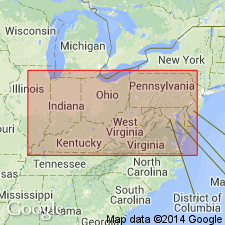
- Usage in publication:
-
- Fairview formation
- Modifications:
-
- Named
- Dominant lithology:
-
- Limestone
- AAPG geologic province:
-
- Cincinnati arch
Summary:
Named for Fairview Heights in Cincinnati, OH. About 100 ft thick. Has two faunally defined members, Mount Hope and overlying Fairmount, which are lithologically inseparable. Underlain by Eden formation, overlain by McMillan formation.
Source: GNU records (USGS DDS-6; Reston GNULEX).
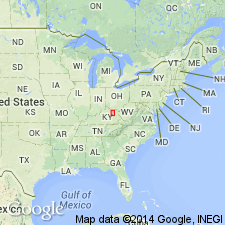
- Usage in publication:
-
- Fairview Formation*
- Modifications:
-
- Overview
- Dominant lithology:
-
- Limestone
- Shale
- Siltstone
- AAPG geologic province:
-
- Cincinnati arch
Summary:
Fairview Formation adopted for use by USGS in KY. Consists of closely interbedded limestone and shale and minor limy siltstone. Limestone makes up 50-60 percent of the formation. It is 80 to 90 ft thick. Conformably overlies the Kope Formation; conformably underlies the Grant Lake Limestone.
Source: GNU records (USGS DDS-6; Reston GNULEX).
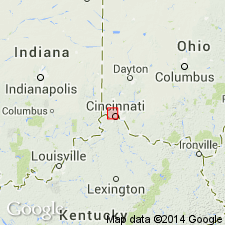
- Usage in publication:
-
- Fairview Formation
- Modifications:
-
- Redescribed
- Revised
- Dominant lithology:
-
- Limestone
- Shale
- AAPG geologic province:
-
- Cincinnati arch
Summary:
Fairview Formation, originally faunally defined, redefined as a lithologic unit. Type section designated. Interbedded shale and fossiliferous limestone in which no stratum is consistently thicker than 1.5 ft and generally no more than 0.6 ft. 108 ft thick at type section. Tongue of Fairview, called North Bend Tongue, which extends north and west from Cincinnati, OH, into Kope Formation, defined at base. Fairview underlain by Kope Formation, overlain by Miamitown Shale.
Source: GNU records (USGS DDS-6; Reston GNULEX).
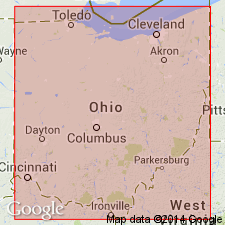
- Usage in publication:
-
- Fairview Formation
- Modifications:
-
- Revised
- AAPG geologic province:
-
- Cincinnati arch
Summary:
The Geological Survey of Ohio recognizes the Cincinnati Group proposed by Meek and Worthen (1865), but at this time retains it as an informal term. The unit will be formally reinstated as a lithostratigraphic term after revision of its lower boundary and minor lithologic redescription of its units are completed. The ten formations included in the group are the (ascending) Clays Ferry Formation, the Kope Formation, the Fairview Formation, the Miamitown Shale, the Grant Lake Limestone, the Arnheim Formation, the Waynesville Formation, the Liberty Formation, the Whitewater Formation, and the Drakes Formation. Six members have been identified in the course of field mapping: the Point Pleasant Tongue of the Clays Ferry, the informal Bellevue, Corryville, Mount Auburn, and Straight Creek members of the Grant Lake Limestone, and the Preachersville Member of the Drakes Formation. The Backbone Creek and Elk Creek beds are recognized as excellent stratigraphic marker beds.
Source: GNU records (USGS DDS-6; Reston GNULEX).
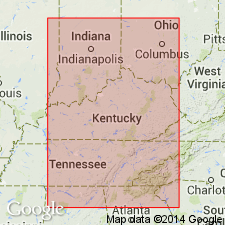
- Usage in publication:
-
- Fairview Formation*
- Modifications:
-
- Overview
- AAPG geologic province:
-
- Cincinnati arch
Summary:
The Fairview Formation in north-central KY and southwestern OH consists of medium- to coarse-grained skeletal limestone in the lower part and fine-grained, silty limestone in the upper part, both parts being interbedded with shale and minor siltstone. Unit is sparsely fossiliferous. Thickness is 70 to 110 feet. Conformably overlies and intertongues with the Kope Formation and conformably underlies the Miamitown Shale or Bellevue Limestone locally or the Grant Lake Limestone elsewhere; unit grades westward into the Kope and Dillsboro Formations and southward into the Ashlock Formation of KY. The Fairview is of Late Ordovician, generally Maysvillian, age, but locally may be as old as Edenian.
Source: GNU records (USGS DDS-6; Reston GNULEX).
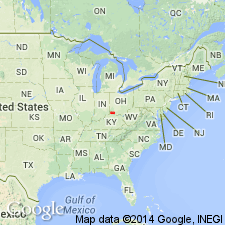
- Usage in publication:
-
- Fairview Formation
- Modifications:
-
- Overview
- AAPG geologic province:
-
- Cincinnati arch
Summary:
The Kope-Fairview-Bellevue succession is the first of three major progradational units that compose the Cincinnatian Series in the Cincinnati, OH, area. Each succession is interpreted as a mixed siliciclastic-carbonate ramp. The Kope Formation is the most distal facies of the ramp complex. The Fairview Formation is the intermediate-depth lithofacies in the upward-shoaling succession. Unit is 20 to 35 m thick and is composed of subequal proportions of thin-bedded, fine to coarse skeletal limestone and gray, thin-bedded shales and minor siltstone. The North Bend Tongue is separated from the main body of the Fairview by the Wesselman Tongue of the Kope. The North Bend becomes indistinguishable 15 to 20 km northwest of Cincinnati. Faunal assemblages in the Fairview are marked by changes in type and morphologic character due to an increase in physical energy. Larger brachiopods and ramose trepostome bryozoans are common. Interfingers to the southeast with Calloway Creek Formation and to the northwest with the upper part of the Kope Formation. Age shown as largely Maysvillian; Edenian very locally south of the Ohio River.
Source: GNU records (USGS DDS-6; Reston GNULEX).
For more information, please contact Nancy Stamm, Geologic Names Committee Secretary.
Asterisk (*) indicates published by U.S. Geological Survey authors.
"No current usage" (†) implies that a name has been abandoned or has fallen into disuse. Former usage and, if known, replacement name given in parentheses ( ).
Slash (/) indicates name conflicts with nomenclatural guidelines (CSN, 1933; ACSN, 1961, 1970; NACSN, 1983, 2005, 2021). May be explained within brackets ([ ]).

